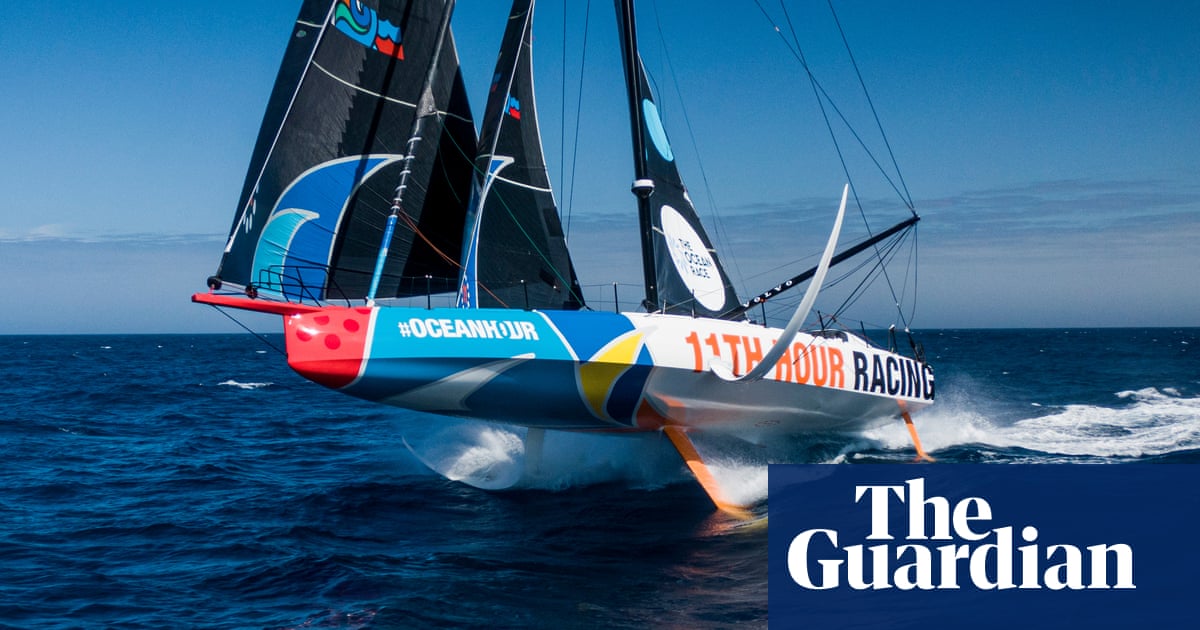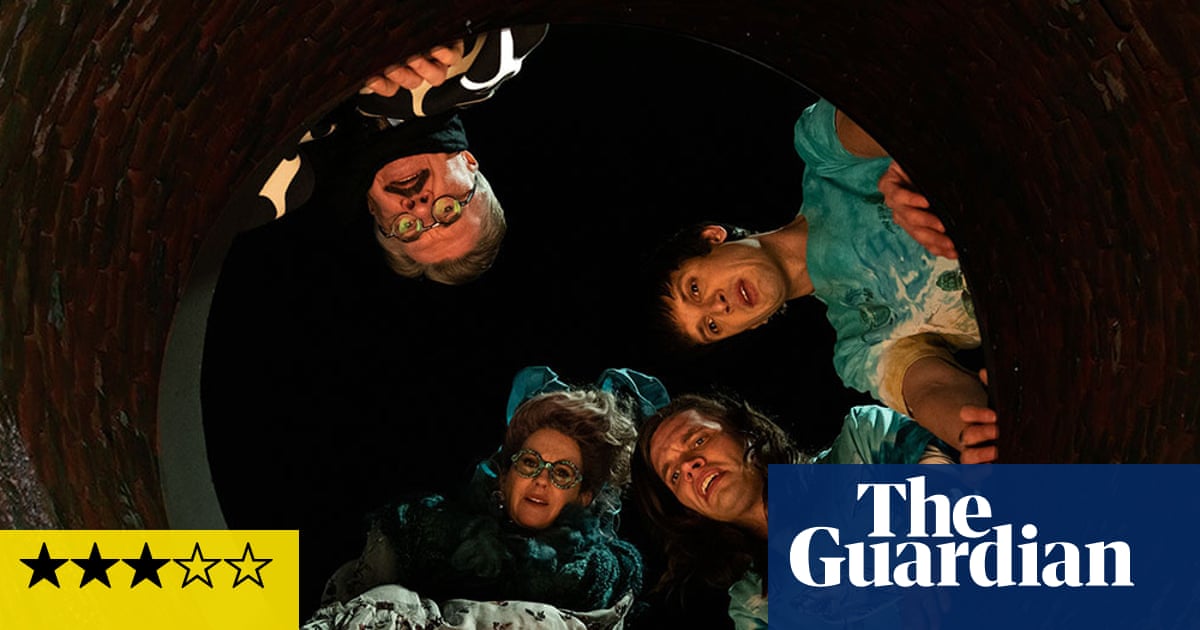
It is almost exactly 10 years since Salvator Mundi was unveiled, this “lost Leonardo” instantly triggering astonishment around the world. Since those giddy days, the work has had a turbulent time. As well as becoming the most expensive painting in history, going for $450m (£326m) at auction, Salvator Mundi was denounced by many as a fake and subsequently vanished from view. The painting is now the subject of The Lost Leonardo, a documentary by Andreas Koefoed that opens in cinemas this week.
“I would be surprised,” says Luke Syson, “if I went to see this documentary.” Syson is the curator who, back in 2011, first displayed The Saviour of the World, as its title translates, at the National Gallery’s Leonardo da Vinci blockbuster. Syson is probably making a wise choice. He’s in the film and the way he clams up mid-interview makes him look like the archetypal embarrassed expert caught out on screen.
This is very much in keeping with the tone of the film which, Koefoed tells me, is like The Emperor’s New Clothes: puffed up institutions and authorities declare they’ve discovered a Leonardo, only to be exposed and mocked. At one point, art critic Jerry Saltz – who doesn’t believe Salvator Mundi is even a decent painting, let alone one by Leonardo – does a flamboyant imitation of a posh connoisseur. Elsewhere, a German curator questions the National Gallery’s ethics in exhibiting, and putting its imprimatur on, a picture it knew was up for sale.
But The Lost Leonardo is about so much more than this. While raising every possible doubt about how genuine this painting of Christ is, the film follows the work’s murky path to the present day. We see sinister shots of deserted freeports where, the film suggests, it was kept by its previous owner, the Russian businessman Dmitry Rybolovlev, as well as footage of the black-windowed superyacht where some say it is held by its current possessor, Mohammed bin Salman, crown prince of Saudi Arabia.
The film chronicles a modern mystery where the world’s most coveted artwork is just a pawn in games of money and power. There are interviews with dodgy art dealers and nauseating promotional footage from Christie’s at the time of its auction, in which tearful people ham up their wonder in front of the painting of a staring, spooky Christ. This is all set against images of bank vaults and even one murder (Bin Salman has been accused of involvement in the murder of journalist Jamal Khashoggi). It leaves Salvator Mundi looking like a fantasy cooked up to bolster some of the richest and nastiest people on earth.
“Poor painting,” art historian Martin Kemp, who’s in the film, says to me. “It deserves better that this.” Dianne Modestini, the New York University expert who restored the long-forgotten, damaged work before it went on the market, agrees. “It really is a tragedy.” But, as Koefoed tells me, there is a twist, if not several. The Lost Leonardo follows hot on the heels of another documentary, The Saviour for Sale. Shown on French TV this spring, the film claimed the painting didn’t show up as expected in an exhibition at the Louvre two years ago because the Paris museum did its own scientific analysis and deduced Leonardo “only contributed” to it. This was widely reported as the last nail in the coffin for the painting’s authenticity.
However, Koefoed’s film gives a different account. The Louvre, it says, actually backed Leonardo as the painter of Salvator Mundi. The reason the painting was never shown was because of Bin Salman’s vanity: he wanted it displayed next to the Mona Lisa to hype it as “the male Mona Lisa”. The Louvre refused. Kemp backs this version, saying he has seen the museum’s buried study. He confirms that it names Leonardo as author.
Yet, for all this, Koefoed’s film tells this as a human story, and at its heart is Dianne Modestini. The restorer – who has been accused by some of over-restoring a severely damaged original, and even of turning a work by a lesser artist into “a Leonardo” – emerges as passionate, sincere. She reveals how working on the restoration helped her cope with the loss of her husband, also a revered restorer. The film follows her quest for vindication, accompanying her to the Louvre to see Salvator Mundi again at its 2019 exhibition – only to capture her confounded by its absence She hears rumours of, and finally tracks down, the Louvre’s suppressed verdict on the painting’s true authorship.
When I spoke to Modestini, she was as sympathetic as she is on screen, and very disturbed by the possibility the work may be on a superyacht. “At first I thought, ‘No, that’s ridiculous.’ But then I considered the size of this boat. It’s a floating hotel. I want to know it’s safe because the panel is so extremely fragile. It’s not meant to be in the enclosure it’s in for ever. It’s meant to be changed from time to time.”
Yet other people who have played a big part in the story, including Syson and Kemp, get short shrift. Their voices are just part of a hubbub of witnesses in which the major tone is massive scepticism. I found myself wanting to hear more about Leonardo’s art and a bit less about freeports: after all, if this really is a rediscovered work by the greatest artist-scientist of all time, isn’t it a wonder of the world whatever chicanery and cynicism surround it? And in the end, The Lost Leonardo concludes that that is probably the case.
If so, the people who leapt on this obscure work and acclaimed it as a Leonardo were not naive, let alone dodgy. They were right. Syson, now director of the Fitzwilliam Museum in Cambridge, tells me the story he fails to get across in The Lost Leonardo: how, as a young Renaissance expert at the National Gallery, he made what seemed the discovery of a lifetime. It started, he remembers, with an old-fashioned slide shown to him by his boss. “You get sent stuff as an art historian at a big institution,” he says. “More often than not, the theory that this is by X – especially if it’s Leonardo or Raphael or Michelangelo – is going to be pretty mad.”
But when National Gallery director Nicholas Penny shared a transparency of this possible Leonardo, Syson was intrigued. He went to New York to study the painting. He and Penny agreed it was something special.
“We were aware that it was owned by a consortium of dealers,” he says. “So the question then became: was the scholarly and public interest great enough to warrant [displaying] the picture?” This was weighed against “the danger of seeming to support something we knew would, with a National Gallery imprimatur, become significantly more valuable. What we decided to do was to invite a small group of Leonardo scholars to ascertain if our judgment was backed by theirs – and frankly, to retreat if any significant doubt was raised.”
So some of the most eminent international experts on Leonardo were called to a skylit studio in London to contemplate the Messiah. “We weren’t ‘authenticating’ the picture,” he says. “It wasn’t about it going on the market. It wasn’t anything other than due diligence.” Kemp was among those experts who gave Syson the consensus he was hoping for. “Yes,” says Syson, “there were anxieties about condition, but my understanding was that those experts believed they were looking at the lost original Salvator Mundi that we knew existed.”
It seemed a clear enough collective verdict for Syson to go with his instincts, put it in the show and write a passionate catalogue entry declaring Salvator Mundi to be a rediscovered Leonardo.
What gets lost in the controversy that now surrounds every aspect of Salvator Mundi is any realistic account of human motivation. Why did experts fall head over heels for this painting? If they were just the elitist monsters caricatured by hostile witnesses here, presumably it was just a noxious cocktail of arrogance and vanity.
But even before he tells me, I know why Syson was so excited about Salvator Mundi: because its intense stark image of Christ fitted the almost mystical Leonardo his exhibition set out to show. Syson wanted to focus on his religious paintings rather than his materialist notebooks, to “rescue him from pure science”. For Leonardo is not only the most celebrated artist of all time, he was also one of the first scientists to dissect bodies to learn anatomy, studied bird flight to imitate it with his own flying machine and even collected and correctly understood fossils. Some find his scientific notes even more exciting than his art. So you can see why Salvator Mundi seemed like a gift from heaven for Syson: proof he believed, after all. “What is he saying here?” wonders Syson. “That I can see the face of Christ – and I can make it present. His Christ has that sort of otherworldly, extraworldly presence.”
Kemp, meanwhle, has done more than most to explore the “pure science” of Leonardo. Since publishing his first study of the ideas and art of the Tuscan polymath in 1981, he has worked out what he sees as the coherent system of thought behind what seem like almost random, chaotic jottings in thousands of surviving notebook pages.
But Kemp too embraces the religious power of Salvator Mundi. “Leonardo was not an atheist,” he says. “It’s a religious picture.” As such it confirms his theory that as Leonardo got older he was more conscious of a “prime mover”. Salvator Mundi for him shares the spirituality of late Leonardo works. “These are paintings of the ineffable.”
Kemp, unlike Syson, is happy to be in The Lost Leonardo. “It’s an amazing parade of grotesque characters,” he says. “The size of their egos is only matched by the wrongness of their opinions.” Salvator Mundi, he adds, has become a target for every art world pseud: “Provided someone can make a provocative statement and make it sound good, they don’t really bother about accuracy.”
In a way, it’s surprising that the Emeritus Professor of the History of Art at Oxford bothers to share the screen with these “grotesques”, yet what impresses me about Kemp’s steady arguments that Salvator Mundi is by Leonardo is how he is trying to share a deeper understanding of the way this genius thought. When he tells me about “the painting of the hair, where he’s doing what I call the physics of hair, like the physics of water”, it makes me see afresh Leonardo’s drawings of spiralling waves. This is not just about a painting, it is about how a genius thought.
Modestini, who has spent longer than anyone staring into the eyes of Salvator Mundi, also has a feel for the vast, shadowy mind of Leonardo. While she agrees the work is intensely mystical, she does not believe it is orthodox. “Maybe it’s not his confession of Christianity. There are rules about depicting Jesus. He’s supposed to have a beard. And he’s not supposed to be so scary-looking. He’s supposed to love us – we have an individual relationship with him. But no one has an individual relationship with the divinity in this picture. This is a divinity who just is. He’s all-powerful, he’s remote, he doesn’t care about human beings particularly, and he controls the entire cosmos.”
So this is a heretical and subversive work? That sounds like the Leonardo I know and love. On screen, Modestini seems defeated in her search for the truth about the lost masterpiece, until finally she reads the Louvre report. “They completely accepted it, with no reservations whatsoever. Various authors disagree on the date, but otherwise there’s no, ‘Well, maybe this part is by …’” Kemp adds: “The Louvre had no reason to produce a spurious report. If they’d done so, they would have been in real trouble.”
Given the two sides of Leonardo, it is perhaps ironic that science, in the form of the Louvre’s technical analysis, seems to have given a firm answer to the $450m question. That makes the story of wealth and power told so hauntingly by The Lost Leonardo all the more disturbing. If it was a fake, its fate wouldn’t be important. Ever since the fire at Windsor Castle, where the Queen keeps her Leonardo drawings, I have felt his works should be held in some kind of Unesco vault as treasures of humanity. Instead, they have been baubles for monarchs and billionaires for five centuries. Just as a fire-prone British castle seems an odd place to keep masterpieces by Leonardo, so does a superyacht. These works are too precious to merely decorate the houses of Windsor or Saud.
The Lost Leonardo is in cinemas from Friday 10 September.












